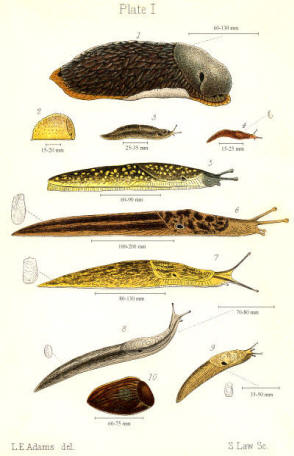Slugs are probably responsible for most harm done to plant foliage in UK gardens. They are quite easily controlled, but there is a lot of controversy over the main means of control - Metaldehyde. We have no problems in suggesting this as a means of controlling slugs - see here.
There are many different types of slugs. They are all vegetarian, so partial to virtually any plant in your garden! Some slugs are happy to spend life above ground, chomping away at foliage and flowers, other slugs live most of the time below ground, making a meal out of roots and tubers - ie bulbs, potatoes, dahlias etc.
It is with the above-ground type that we normally see the damage. The slugs that live below ground are not normally noticed until the plant collapses, or until you harvest your spoilt potatoes etc.
Slugs attack a wide range of plants, but are probably associated with the rather delicate skeletons of Hosta leaves that are left behind after an attack by slugs. Lupins and Delphiniums are also at risk, as are many vegetable plants - lettuce in particular.

Basically, if the foliage is tender - ie new - then it is a meal for a slug.
Slugs are normally nocturnal creatures - not a consideration with the below ground types - and the damage caused is often not seen until the following morning - after a bit of a feast by a party of marauding slugs.
Slugs are normally happiest in damp cool conditions, and this is certainly the best environment in which to find and or destroy them. During the day, they normally live beneath stones or other garden debris.
Environmentalists will have to choose between leaving heaps of debris about the garden for wildlife and putting up with the emerging slugs of an evening!
CONTROL
Slug pellets are the standard method of dealing with
slugs. Used properly, they are considered harmless. We will
not go into the arguments here - we have written and
researched it
elsewhere .
Do not use slug pellets by leaving little heaps as this is
is counterproductive to the control of slugs! .
Metaldehyde - used in the normal blue slug pellets - is actually a repellent for slugs. However it is only present in slug pellets in small percentages - normally 3-6%. the rest of the pellet is made up of either yeast or bran or other 'carrier' which attracts the slug. Leave in heap and the Metaldehyde content is enough to turn the slug away! ALWAYS sprinkle sparingly if you really want to control slugs. There is less likelihood of any accidental eating by garden pets if this method is used. best used on a warm evening during dry weather conditions.
Methiocarb Slug pellets are also available as an alternative. However it breaks down in the soil over a longer period.
OTHER METHODS OF SLUG CONTROL
Slugs can be trapped - drowned even - by leaving out containers partially filled with beer! The slugs are partial to a pint, and drown themselves!
Another method for the less squeamish, is to attach a sharp nail to the end of a bamboo cane or stick and go slug hunting with torch and said weapon during damp evenings. The lawn is a great place to find slugs on a damp warm dewy evening. The resultant speared slug bodies can then be consigned to the compost heap - or somewhere - Yuk!
You can don a pair of plastic gloves, and go slug hunting amongst your flowers and vegetables and simply 'collect' slugs for disposal as you see fit!
A ring of grit, around prized perennials is also a bit of a barrier to rampaging slugs.
Main Page for Apple Tree Problems